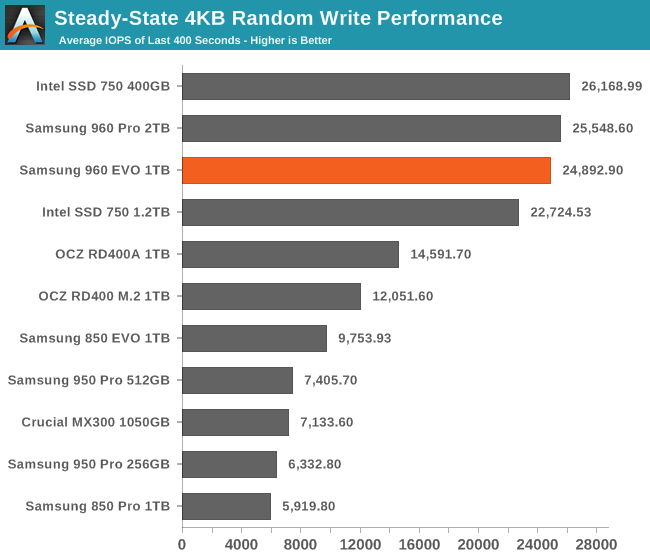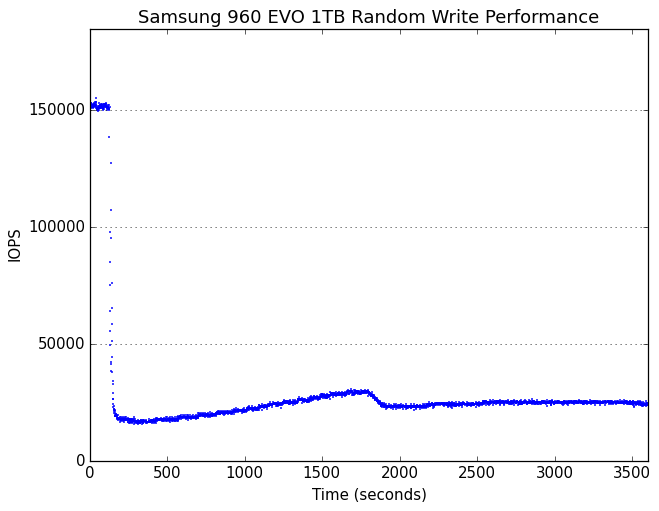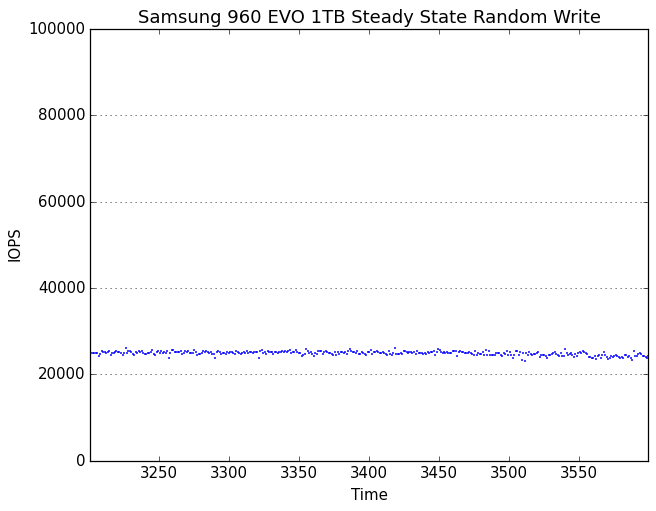The Samsung 960 EVO (1TB) Review
by Billy Tallis on November 15, 2016 10:00 AM ESTPerformance Consistency
Our performance consistency test explores the extent to which a drive can reliably sustain performance during a long-duration random write test. Specifications for consumer drives typically list peak performance numbers only attainable in ideal conditions. The performance in a worst-case scenario can be drastically different as over the course of a long test drives can run out of spare area, have to start performing garbage collection, and sometimes even reach power or thermal limits.
In addition to an overall decline in performance, a long test can show patterns in how performance varies on shorter timescales. Some drives will exhibit very little variance in performance from second to second, while others will show massive drops in performance during each garbage collection cycle but otherwise maintain good performance, and others show constantly wide variance. If a drive periodically slows to hard drive levels of performance, it may feel slow to use even if its overall average performance is very high.
To maximally stress the drive's controller and force it to perform garbage collection and wear leveling, this test conducts 4kB random writes with a queue depth of 32. The drive is filled before the start of the test, and the test duration is one hour. Any spare area will be exhausted early in the test and by the end of the hour even the largest drives with the most overprovisioning will have reached a steady state. We use the last 400 seconds of the test to score the drive both on steady-state average writes per second and on its performance divided by the standard deviation.

The 960 EVO's steady state random write speed is not quite as fast as the 960 Pro, but it's in the same league and much faster than most consumer SSDs.

The 960 EVO sets a new record for combining high performance with consistency. It's a bit slower than the 960 Pro, but less variable.
 |
|||||||||
| Default | |||||||||
| 25% Over-Provisioning | |||||||||
Highly consistent performance is a good thing, but it makes for a boring graph. The transitions from peak to sustained performance modes look the same for both the 960 Pro and the 960 EVO.
 |
|||||||||
| Default | |||||||||
| 25% Over-Provisioning | |||||||||
The 960 EVO responds to extra overprovisioning with even more consistent (and high) performance.










87 Comments
View All Comments
Gigaplex - Tuesday, November 15, 2016 - link
I think they're trying to say the performance isn't great. Failing means we don't get to see the performance numbers.Dave Null - Tuesday, November 15, 2016 - link
This is indeed frustrating. I was expecting the 960 Pro drives I preordered to arrive last week. Now Amazon is reporting January.Something major must have happened for Samsung to miss its release date so badly, but nobody is reporting it.
Flying Aardvark - Wednesday, November 16, 2016 - link
I went with the 600P 1TB instead.. had it for 2 weeks now.. I love it. Being M.2 I didn't buy it for heavy workloads anyway so it won't throttle. But if I needed performance I'd go with the Intel 750 instead of what I got.Phattio - Wednesday, November 16, 2016 - link
my 960 Pro 512GB arrives today. ordered from best buy online.Kristian Vättö - Thursday, November 17, 2016 - link
There is a simple explanation: NAND shortage.XabanakFanatik - Thursday, November 17, 2016 - link
Of course! I'm glad you had an article about it. Oh, wait.I'm fairly certain that people need to know that despite your reviews coming out on time that they won't be able to buy the products for months.
zanon - Tuesday, November 15, 2016 - link
Interesting to see the rate at which these continue to progress, and I'm glad Samsung continues to ramp performance aggressively. One thing I wish you could find some way to integrate is at least a summary of reliability features like how a drive handles power loss, and (depending on feasibility if you are mainly testing short-term loaners) maybe some followup a few months down the line with longer term performance/reliability observations. While Samsung has long been at or near the pinnacle of out-of-box raw performance, they've also had a history of playing a bit fast and loose with reliability and support, and I think that deserves some sort of recognition. I have a lot of Intel 730s that replaced or were chosen over Samsung drives of the time after a number of poor experiences with the long term usage 840 series for example, and while the 840s were superior in many respects on paper and Day 1, by Day 100+ and under stress they developed issues that were not immediately apparent.Also, a small typo on the final page, looks like at least one of the $/GB (the 750@1TB) isn't right.
Billy Tallis - Tuesday, November 15, 2016 - link
I am working on some longer-term data and performance retention testing, but the amount of extra equipment that requires means not many drives will get that treatment. Unexpected power loss testing might be more feasible, but for the near future the testbed is too busy for me to add something like this to the routine.The Intel 750 doesn't fit conveniently in the price comparison chart because of its unusual capacities. The prices listed are for the 400GB and 1.2TB models, and the 800GB model isn't listed in the table.
Bullwinkle J Moose - Tuesday, November 15, 2016 - link
Speaking of long-term data retention......If I had 2 SSD's, one unplugged and stored in a closet and one plugged in with power on but idle and unused, would the one plugged in retain data longer even though it is unused????
patrickjp93 - Thursday, November 17, 2016 - link
Yes. There is wear leveling and data refresh in modern SSDs (840/Evo being the exception with cell band drift)